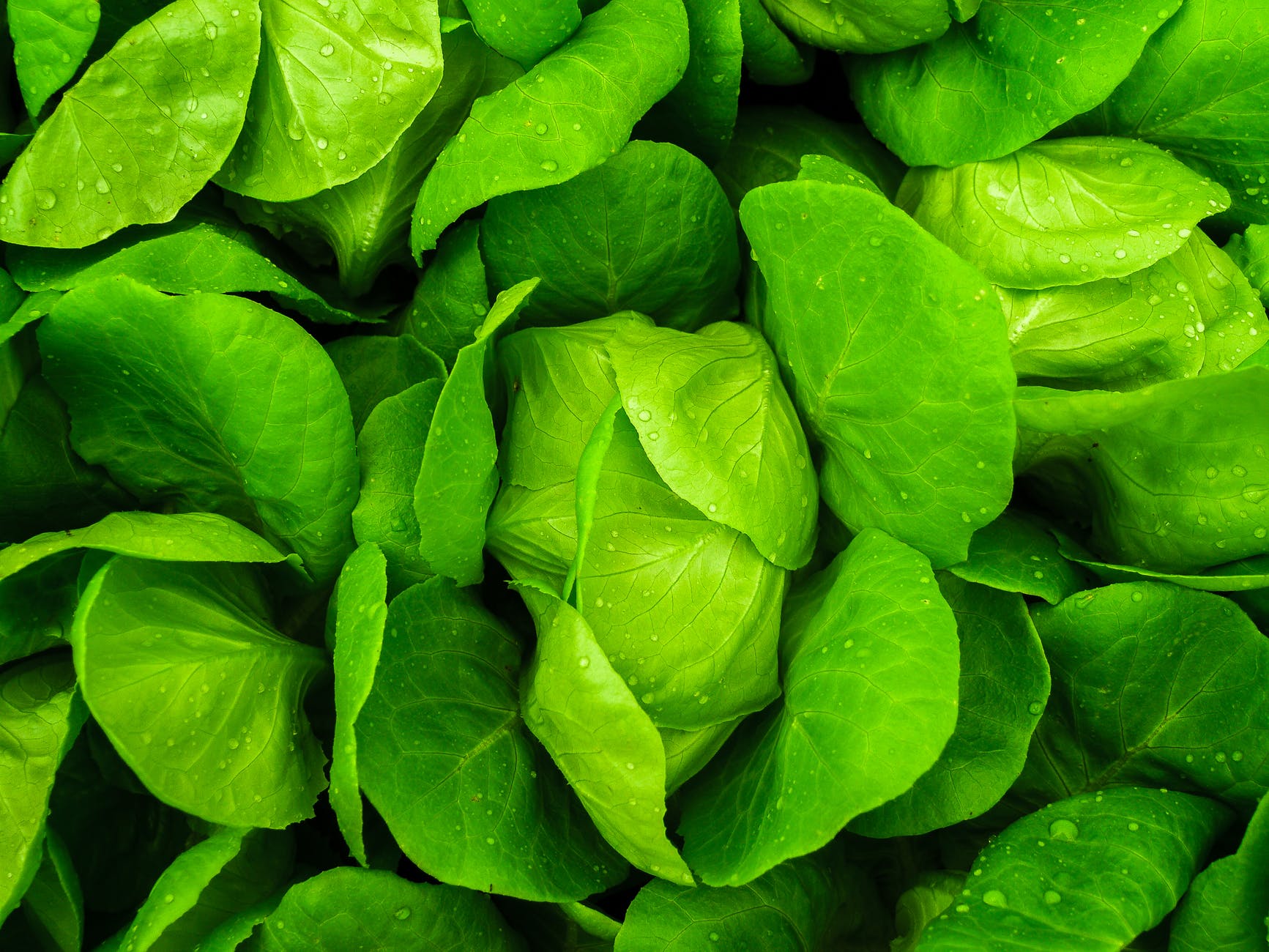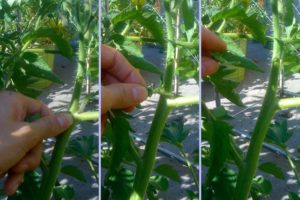[vc_row][vc_column][vc_column_text]Planting your own fruit vegetable garden in your yard is an amazing idea to save money. Growing one plant of tomato can give you 10 pounds of fruit throughout the season. By planting fruit and vegetables in pots let you feel the pleasure of savoring sun-warmed delicious tomatoes fresh from your garden. Additionally, growing vegetables in raised beds and containers can be fun’ as it is one of the best ways to spend time outdoors in the warmed weather, our tricks and tips will assist get you the best fruit vegetable garden at your own backyard this season.
The Ultimate Guide to Vegetable Gardening for Beginners
Choose a place to plant fruit and vegetables:
You have planned to plant fruit vegetables in your garden but the only question is what the location of a fruit and vegetable garden will be in your garden. so don’t worry we provide a guide to How to plant fruit vegetables in your own garden – An ultimate guide, Choosing a location to plant fruit and vegetables is quite complicated. What type of soil? How much sun? Don’t panic. It is not much hard to choose a place for a fruit vegetable garden as long as you keep some little things in mind.
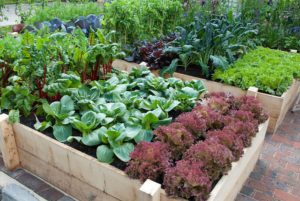
Convenient
The Position of a fruit vegetable garden should most importantly be decided for comfort. After all, fruit vegetable garden is for your happiness. In the event that you need to walk 10 minutes to the area of a fruit vegetable garden, chances are enormously decreased that your spot for a vegetable garden will be watered and weeded as much as it ought to and you may pass up a great opportunity for harvesting frequently.
Sun
Sun is another important thing to consider while planting fruit vegetables in your yard. Choose a location where your vegetables can get enough sunlight. Generally, fruit vegetables require a maximum of 6 hours of sun, though 7-8 hours is better. Don’t panic much about if the location for a fruit vegetable gets afternoon or morning sunlight, just make sure that it should get six hours of the total.
Drainage
Fruit vegetables can not grown in waterlogged soil. The location of the fruit vegetable should be overhead. If the location of the fruit vegetable is in the ground or at the bottom of the hill, the it will have a tough time drying out them and the plants will suffer.
2. Choose suitable fruit vegetable to plant
Choosing what to plant in a vegetable garden is simpler than you might suspect. On the off chance that you figure it right, you can appreciate a wonderful compartment vegetable garden or raised bed vegetable garden without spending hours watching out for it. When choosing what to plant in an apprentice vegetable garden, it’s best to begin little. Numerous plant specialists can get excessively energised toward the start of the season and plant more warm-season vegetables than they require.
To start with consider the amount you and your family will eat. Remember vegetables like tomatoes, peppers, and squash continue giving all through the season—you may not require numerous plants to serve your necessities. Different vegetables, for example, carrots, radishes, and corn, create just once. There are so many fruit vegetables that you can grow in your yard. Some of the popular fruiting vegetables are eggplant, tomatoes, peas, sweet corn, cucumber, watermelons and peppers.
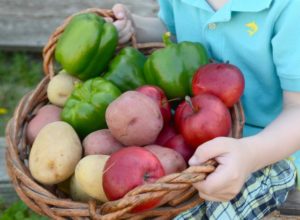
Tomatoes
Tomatoes are one of the most popularly grown vegetables. They do not need much space to grow these fruity vegetables need 1-10 feet tall and 1-4 feet wide area. But as mentioned above it needs proper sunlight of 7-8 hours a day to grow.
Eggplant
Eggplant needs around 1-3 feet tall and 1-2 feet wide area to grow. These purple flowered vegetables also need complete sunlight to grow fully.
Potatoes
Potatoes needs 1-2 feet tall and 1-2 feet wide area to grow. These root vegetables needs direct sunlight in order to grow.
Carrots
Carrots need 6-15 inches tall and 6-15 inches wide.carrots can grow in partial and direct sunlight.
Watermelon
It needs 1-3 feet tall and 5-20 feet wide area to grow! They also need complete sunlight to grow big red watermelon.
Pumpkin
Pumpkins develop in the vicinity of one and two feet tall and between ten to twenty feet wide. These monster vegetables require full daylight keeping in mind the end goal to develop effectively.
Peas
Peas are another especially well known fruiting vegetable. Peas develop in the vicinity of one and seven feet tall and in the vicinity of six and twelve inches wide. These most-loved vegetables require finish or incomplete daylight to develop effectively.
Sweet Corn
Sweet corn or corn isn’t only a monetarily cultivated vegetable, these veggies can be developed at home. Corn develops to in the vicinity of four and eight feet tall and in the vicinity of one and three feet wide. Corn requires guide daylight with a specific end goal to develop.
3. Select soil type
How to plant fruit vegetables in your own garden – An ultimate guide, If you are growing fruit vegetables and confused about the location! Then choose the place with loamier soil. To Grow fruit vegetables you will require to ready a plot of the area that is fertile and flat. Since fruity vegetables need proper sunlight to thrive this area of land also needs to be in direct sunlight.
After deciding where you wish to plant your garden then you will require to start to prepare your soil. Choose the soil which is fertile in order to grow a lush garden. You have to check your soil in a ride to see which nutrients you are lacking and which it already contains.
No matter whether you grow fruits or vegetables all need soil that contains proper nutrients. Thus testing your soil permits you to know what types of essential nutrients you will require to add in your soil to make your fruit vegetable growth properly.
To test your soil you need to take a soil sample from the land where you are going to grow the garden. Ideally, all soil in that area will be the same so you can take a container and fill it around 1 or 2 cups to take samples. It is better if you take from the various areas that cover fruit vegetable growing areas.
Take soil sample when it is dry, but if you find that soil sample is damp you can set it out and let them dry before sending for testing in the laboratory. There are so many options available when it comes to soil sample tested, if you are a beginner you should avoid testing samples on your own. Now I can prefer professionals for this work. The best you can do is to search online and there you will find so many nurseries who offer excellent soil testing services, and can perform testing for you.
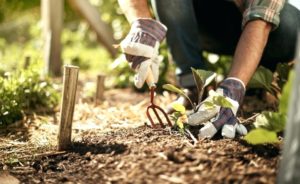
How to Plant potatoes?
-
Plant the potato seeds. Certified potato seeds are recommended as grocery store seeds can harbor disease that might ruin the entire crop.
-
First plant seed at a warm plot before planting it. When sprouts are formed ½ inches long, this means potatoes are ready to plant.
-
Cut potato seeds in large chunks. Let them stay at room temperature for around 2 or 3 days.
-
Potatoes need good sunshine and loamy soil. Work some compost into the yard bed. Add fertilizer 05-10-10 as recommended.
-
Dut the potato seeds with agricultural sulfur through putting sulfur as required in a bag, add potatoes, and shake them well. This will protect seeds from fungal diseases.
-
Next step, dig 3-4 deep holes and place the seed in the holes with the eyes pointing upward. After this cover the seed with soil and water it well.
-
Harvest the potatoes, Potatoes mature in more than 100 days. One sign that potatoes are ready to harvest is that the potato leaves will look yellow and the foliage will bend back.
-
It’s the best time to leave them in the ground for 3 weeks or more the potato skin toughens up.
It’s the best time to leave them in the ground for 3 weeks or more the potato skin toughens up.
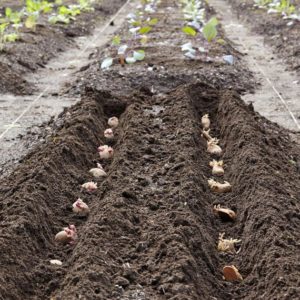
How to Plant Tomato?
-
Start planting tomato seeds indoors 5-8 weeks before the last frost.
-
Next step is to buy plastic pots for growing seedlings
-
Fill that pot with moistened soil as per your choice
-
Sow 3-5 seeds deep in soil around ¼ inches in each pot.
-
Water only as needed
-
Provide some support as the plant growth.
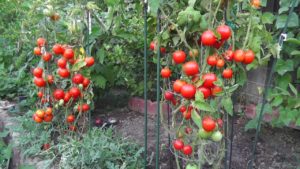
How to plant Eggplant?
-
Remember one thing while growing eggplant, that eggplant planting through seeds can be done in a greenhouse setting or in indoors. This protects seeds from any type of frost.
-
Don’t plant it early, this may hurt the plant. First, warm the soil before you keep the seeds of eggplant outdoors. Because cold soil can kill the eggplant roots. As compared to tomatoes, eggplants are more sensitive to cold soils.
-
Grow them into huge space so they should be placed 20-30 inches apart.
-
Mix 2 inches of compost to improve the planting holes, this will held fertilizer and moisture in the soil.
-
Give water to plants before spreading mulch.
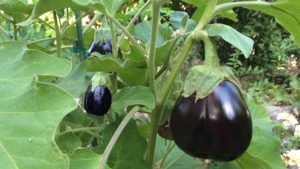
How to Plant Sweet corn?
-
Corn plants are choosy about their soil. Compost the fall even before planting and then let overwinter in it.
-
Planting corn seed indoors not suggested.
-
At the last spring, times plant corn seeds indoors
-
The soil temperature must be 60 For successful germination.
-
In colder areas, the area can be warmed by covering seeds are with black plastic cover only if required. Then, grow seeds through the holes in the plastic.
-
Plant corn seeds deep around 2 inches and 6 inches apart. Row wise 32-36 inches apart.
-
For right pollination plant your seeds right. Plan corn of at least four rows, don’t plant only two rows.
-
You might choose to fertilize while planting time, as corn grow rapidly if you are sure that the soil is right, this process can be skipped.
-
Give sufficient water at planting time.
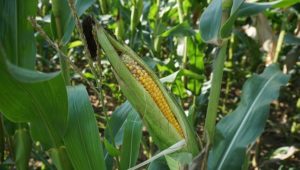
How to grow chilies?
1. Sow indoors in 3 inches pots for around 3 months
2. After this, Transplant into big pots
3. Provide enough sunlight and warmth
4. Do not touch or pinch out the growing tip as this delays cropping Harvest when you find chilies fully ripened It can be grown outdoor but in a sunny sheltered spot.
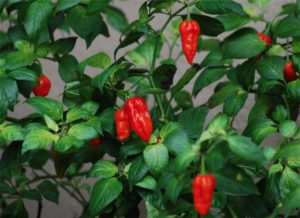
Pros and Cons of planting fruit vegetables in your own garden:
Pros:
Fresh fruits and vegetables grown in your own garden have more nutrients as compare to the ones that have traveled miles to get to the grocery stores.
Having Your kid help you in the gardening can increase the opportunity that they will eat more vegetables and fruits they have assisted to grow.
Plating your own fruit vegetables in your yard can give you the chance to reduce the pesticide that you use in your fruit garden making them nutritious and healthier.
Growing your own vegetables and fruits will save your good amount of money at the grocery store.
Gardening improves physical activity. It is one of the best activities to age whole family members in some physical activity and makes them responsible for the garden.
The fruit vegetables that we grow in our own garden will promote healthy fruits and vegetables as they are highly rich in nutrients, especially in antioxidants, phytochemicals, vitamin A and Vitamin C.
As specified above there are numerous advantages to growing a vegetable garden however one of the greatest for the tenderfoot nursery worker is that developing vegetables isn’t just considerably less demanding than developing specific flowers
yet it likewise conveyed an awesome number of medical advantages.
When discussing the medical advantages of vegetable cultivating we are not simply tending to the way that vegetable planting enables you to develop pesticide-free vegetables, yet we are likewise discussing alternate advantages that originate from the developing procedure. Research has demonstrated that there is an incredible number of benefits of developing your own particular vegetable garden and these include: saving money the advantages of your mental health. the magnificence of having a vegetable garden to take exercise day by day.
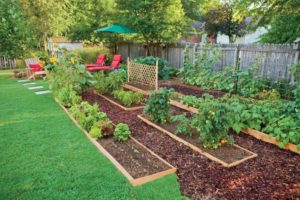
Cons:
Cost
Fruit vegetable gardens may be considered as money-savers, but they come to with their own expenses.
When you start creating your own fruit vegetable garden, potential costs include a shovel, hoe, tiller, rake, and edging material.
After this, the yearly costs are not so much but expenses still include plants, compost, seed, fertilizers, topsoil, support systems like tomato cages, and mulch.
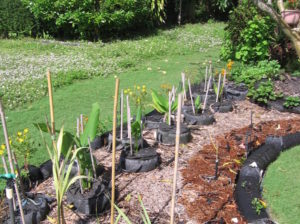
Lost space
A garden covers a big space of your lawn. If your land is small, this means very less space you have for other activities like playing, entertaining. Thus, fruit and vegetable gardening comes with it’s cons also.
Crop loss
Home gardeners often face crop loss because of wildlife and pests. Many beginner gardeners prevent these issues with chemical pesticides, which cause ecological damage and health problems.
Injuries
Gardening needs physical exertion, including stooping, carrying digging and lots of bending. In the gardening process repeated bending stooping cause a strain on your joints and back.
Time
A personal garden needs a lot of time from the very first stage though harvest time. It needs great efforts and time when you begin planting your garden, as the work will continue to do the entire growing season. You have to water it on time, fertilise the plants on time, all this needs good amount of time.
7 Ways of plucking the vegetables from plants
Shake the plant
Shake the plant and the fruits and vegetables fall off, this is the first method and the quickest one to pluck vegetable and fruits. For this you are only required a large sheep a few willing bodies place then under the plant. Choose a fruit filled branch and shake it well. It is a very useful way to get all the fruit off from plant.
Use a vegetable -fruit picker basket
This one is best way for reaching towards those fruits which are far from your reach and through picker basket you can pulled off them easily. You can use a vegetable fruit picker basket. Wrap the hook of the basket in fruit’s stem and tug it. The fruits will directly fall into the basket.
Prune off vegetables
Use hand held pruners in order to remove vegetables that are tough to remove by just pulling. This is also one of the best and the easiest method of plucking vegetables.
Twist and pull
Some fruit vegetables don’t come off easily from the trees. If you don’t have hand held pruners then grab vegetables fruit individually by twisting and pulling.
Vegetable harvesting knife
Where scissors won’t able to cut the vegetable, you required a sharp, good knife made for quickly plucking down your vegetables, it cut the vegetables without damaging anything.
Clarington Forge Potato Fork
Digging potatoes is one of the tedious task in the gardening world, however using potato fork s a great choice it is especially made for digging potatoes and make potato plucking easy.
Berries Picker
Berries are expensive to buy and also time consuming to pick.however you had panted in your garden and now you feel problem in plucking. You can have this berry picker at your home, it will pluck all the berries off the stems effortlessly.
Feeding your vegetable plant
Vegetables are really heavy feeders. It is good if you have enriched and tested your vegetable soil, soil it is doe then you won’t have to feed much. Work on some organic matter as organic foods will feed your plants through all the seasons. You can also opt for water-soluble fertiliser, but make sure your garden must be well-watered before you apply it.
Feeding your fruit plant
Fruit trees choose an organic nitrogen fertiliser. Soybean meal, blood meal, cottonseed meal, chicken manure, and organic nitrogen sources. There are also some specially formulated fertilisers for fruits. Not only nitrogen more than that your fruit trees also needs trace minerals and organic matter. Cascade generalising and omitted soil boost are the best sources of trace minerals.
What to do if Nothing is Growing?
Sometimes beginners to fruit vegetable gardening experience hopeless feeling o a barren crop. There are so many main reasons why some plants are not able to grow in your garden and it is essential for you to know why this is so so that you will not repeat the mistake in the future.
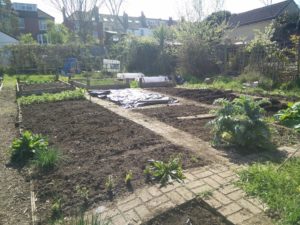
Check your seeds
This is one of the main reasons that if nothing grows in your garden then it means some improper of seeds. If you want your seeds to produce healthy nutrients, you should store them in a proper manner so that seeds can remain healthy without getting damaged.
Seeds can become damaged because of excess moisture and heat. Planting damaged seed will seldom result and this causes no crop in your garden. Before plating seeds, take it to the laboratory for a quick test to check whether seeds are right or something is wrong.
Check sunlight level
Sunlight level is one of the most important factor that affect your gardening. As you know different crops needs different amount of sunlight exposure, but this is also true each crop need specific amount of sunlight to grow. If you observe that the area you have selected for gardening doesn’t get enough sunlight than it is better to choose another plot for gardening to ensure better sunlight exposure.
Check soil nutrient levels
Soil health is yet another big factor to healthy fruit vegetable gardening. Even after tested soil by professionals there are other necessary things that can affect your vegetable gardening is the nutrient levels. If you see nothing grows in your garden, try to get a sample of soil again to test it again in a laboratory. Because without proper nutrients plants cannot grow. So testing soil for the next time shows you the level of nutrient your soil still requires to balance out soil nutrients once again.
Once you have decided your plants, containers, locations, the sky the limit follow the guide step-by-step and you will have a beautiful garden in your yard that brings you healthy fruit vegetables fruits and joy. I hope you enjoy reading How to plant fruit vegetables in your own garden – An ultimate guide.[/vc_column_text][/vc_column][vc_column][/vc_column][/vc_row]
